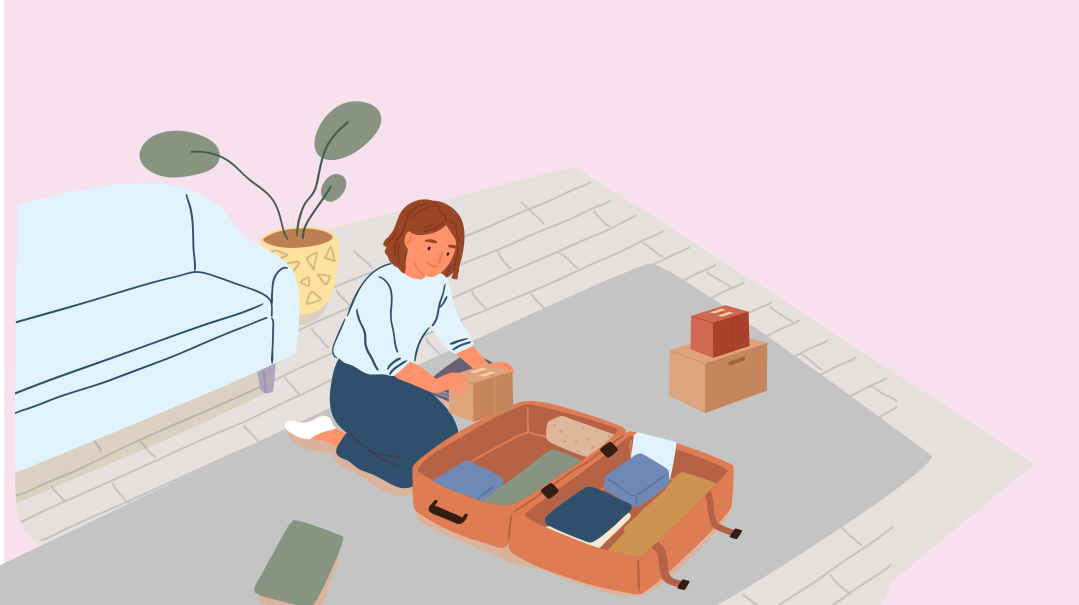The Worry Suitcase
| December 12, 2023By learning to compartmentalize, you can face your challenges without drowning in them

The Worry Suitcase
Shoshana Schwartz
Life’s challenges can consume you. Thoughts plague you as you flit from one pain point to another, leading to a turbulent whirlpool of anxiety.
To get out of the maelstrom, experiment with this visualization exercise:
Imagine a suitcase. What color is it? Is it on wheels? It the shell hard or soft? Is there a handle on the side, top, or both?
Picture a lock on the suitcase. Is it a key lock? Combination?
Open the suitcase, see how roomy it is, and leave it open in front of you.
Now place your hands on your head, and imagine you can feel the thoughts whizzing around inside. Choosing one thought, place it inside a small box, then lay it in the suitcase. Choose another thought, then another, placing each one inside its own box.
You might notice that your brain space is also taken up by fears, emotions, ideas, and even possible solutions. Just place each one into its own box and gently lay it inside. You can make the suitcase as spacious as you need. When the whizzing has quieted down, close the lid and lock the suitcase. Store it somewhere safe, and if there’s a key, put it in a different location. (It’s your imagination; put it wherever you want!)
Wait! It can’t be that simple! I haven’t solved anything!
Correct, you haven’t. You haven’t gotten rid of these thoughts and feelings, you’ve just temporarily contained them.
To make this work for you, you have to schedule a time to actually deal with all the things you placed inside the suitcase. But the advantage the worry suitcase offers is that you can now choose the time and place to do so.
Schedule a worry session (perhaps 20 minutes a day, or twice a week) either with yourself or others with whom you’re navigating this challenge (such as your spouse). During this session, you’ll retrieve the suitcase and key and examine its contents. Now’s the time to think, feel, worry, plan, agonize, strategize, or make difficult decisions. You could also decide that you need to schedule additional time outside the session to deal with things like information gathering or consultations.
When intrusive thoughts pop up at other times, write them down, then place them into your suitcase (via a one-way slot), deferring the angst until your next scheduled worry session. It may take some practice until you’re able to do so, but it gets easier. Once the worry is contained, it’s less likely to spill all over everything in your life.
By storing important thoughts and feelings in a worry suitcase and then getting back to them, you demonstrate that you’re trustworthy and that you’re not in denial or procrastinating or ignoring. You prove to yourself that you really don’t need to keep your worries front and center 24/7, because you’re systematically addressing them in a way in which you’re far less emotionally and physically overwhelmed, and far more clear-headed, able to contemplate and possibly reach effective solutions.
By learning to compartmentalize, you can face your challenges without drowning in them.
Shoshana Schwartz specializes in compulsive eating, codependency, and addictive behaviors.
Change the Soundtrack
Abby Delouya
Whether or not we’re aware of it, we all keep running internal monologues. If these monologues are critical of our spouses, they can cause quiet but serious damage. “He leaves his stuff everywhere!” “She’s always running late.” We may not even be attuned to the negative statements that pervade our thoughts and can have a direct impact on our marriage.
It’s likely, however, that our habit of negative self-talk began with ourselves as the target. In fact, as much as 77 percent of the average person’s self-talk is negative. That means the overwhelming majority of what we tell ourselves is critical, demeaning, harsh, demanding, and possibly straight-up not nice — and we may not even be aware of it!
While these thoughts are rarely noticed, they subtly and continually shape our attitudes, moods, and responses. How can we change something that is so deeply ingrained? One way to battle this destructive habit is to intentionally think and say positive affirmations and statements to yourself. If you practice this enough consciously, eventually it will impact your automatic thinking points.
Another idea: When you notice a negative thought about yourself surfacing, ask yourself, “How is this serving me?” Challenging assumptions and replacing them with truths can disrupt old habits.
When you practice positive self-talk with yourself, you will see the change spill over to your communication with your spouse. Positive self-talk improves the quality of your attitude, emotions, motivation, behaviors, and communication, and your marriage and parenting will be the direct beneficiaries of the increased joy, peace, caring, understanding, and love.
Abby Delouya, RMFT-CCC, CPTT is a licensed marriage and individual therapist with a specialty in trauma and addiction.
Overheard
Zipora Schuck
I was observing in a preschool classroom and overheard a sweet young girl exclaim happily, “Hashem loves me!” after she found the toy she was searching for. When I commented to the teacher how genuine it was, she shared that this student often says touching things like that, or “Thank You, Hashem!” She also told me that, unsurprisingly, the student’s mother also expresses herself like that.
The power of a subliminal message is that our values become part and parcel of our children through osmosis. What do you find yourself saying often?
“Gam zeh ya’avor… Gam zu l’tovah… Hodu laHashem ki tov… Mitzvah gedolah liheyos b’simchah.” Our mantras define our values and ring out loud and clear to our children. What do your children hear in your home?
Zipora Schuck MA. MS. is a NYS school psychologist and educational consultant for many schools in the NY/NJ area. She works with students, teachers, principals, and parents to help children be successful.
(Originally featured in Family First, Issue 872)
Oops! We could not locate your form.







